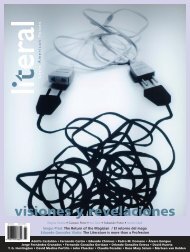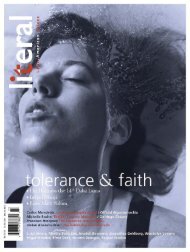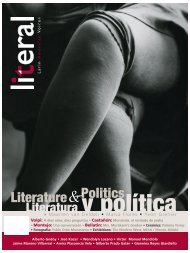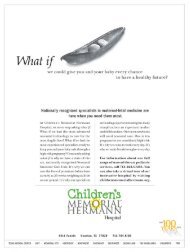Giobany Arévalo > Gabriela Torres Olivares >Anuar Jalife - Literal
Giobany Arévalo > Gabriela Torres Olivares >Anuar Jalife - Literal
Giobany Arévalo > Gabriela Torres Olivares >Anuar Jalife - Literal
You also want an ePaper? Increase the reach of your titles
YUMPU automatically turns print PDFs into web optimized ePapers that Google loves.
Misspent Youth, 2009, collage Last Laugh, 2009, collage<br />
Curtis Gannon <br />
In Comics, Time<br />
Is Always Now<br />
A Conversation<br />
with Rose Mary Salum<br />
Rose Mary Salum: You’ve collected comics since<br />
you were a kid. It seems that you’ve found a<br />
way of expression through them. What is it<br />
about comics that move you, that make you<br />
unfold a whole visual language through them?<br />
Cutis Gannon: I enjoyed comics as a kid<br />
because they were a means of escaping life’s<br />
monotony and frustrations. I was drawn to<br />
the fantastic storylines, the larger-than-life<br />
characters and settings, and the dramatic artwork.<br />
Comic books have the ability to transport<br />
their audiences to anyplace and anytime,<br />
where the impossible is possible. In<br />
retrospect, I realize that comics helped me to<br />
translate and defi ne the pressures of growing<br />
up in our contemporary, urban society. As<br />
an artist, I am fascinated with understanding<br />
how comic books function as a communication<br />
media. My work explores their serial/<br />
fragmented nature, ideas of anticipation and<br />
identity, how they create a sense of time and<br />
place, the fl ow of narrative through sequential<br />
images, the mythical basis of superheroes,<br />
and how they entice the reader into<br />
participating in the narrative.<br />
RMS: Your work entices the observer<br />
into participating not only in the narrative<br />
of your visual language but also in the serial/fragmented<br />
mini explosions of color and<br />
texture creating a world with volume and excitement.<br />
What do you want the spectator<br />
to see/feel?<br />
CG: My work explores the drama, beauty,<br />
and sense of anticipation inherent in comic<br />
books. I want the viewer to be moved by the<br />
use of intense color, suggestive shapes, and<br />
dramatic line. Aware that abstraction can appear<br />
intimidating and perplexing, I reference<br />
comics because of their general approachability.<br />
The visual language of comics has the<br />
ability to surpass age, language, cultural, and<br />
social boundaries. Intimate scale, textured<br />
paint, and the stacking of elements stimulate<br />
our sense of touch, bringing attention<br />
to each piece’s physical qualities. The small<br />
scale of most of my work comments on the<br />
intimate size of comic books. They are a very<br />
personal media, meant to be read by a single<br />
individual, unlike the mass entertainment<br />
of television, radio, and cinema. My compositions<br />
extend to the limitations of their<br />
support, activating the edges. This strategy<br />
suggests that the composition continues beyond<br />
the borders of what is seen, creating<br />
a sense that what is presented is a smaller<br />
portion of a larger whole. It creates an illusion<br />
that makes these works appear larger<br />
than they really are. At their core, comics are<br />
fragments. Each panel is a fragment of the<br />
page, each page is a fragment of that particular<br />
issue, and each issue is a fragment of<br />
34 LITERAL. LATIN AMERICAN VOICES FALL, 2009<br />
an ongoing series. This fragmentation enhances<br />
another of comic book’s fundamental<br />
qualities, a sense of continuous anticipation.<br />
Anticipation is the fuel that propels the action<br />
towards an unforeseen conclusion. The<br />
cover alludes to the issue’s climax, and each<br />
comic book usually ends with some unanswered<br />
question or “cliffhanger” situation.<br />
The desire for resolution perpetually leads<br />
the reader to acquire the next issue or related<br />
issues. I want the work to suggest this<br />
continuum. In terms of narrative content, the<br />
viewer brings their own experiences to each<br />
piece, and bases their interpretation on those<br />
experiences. Like most abstract painting, my<br />
work does not have a set meaning, but is<br />
meant to establish a dialogue with the viewer.<br />
This dialogue is communicated through<br />
ideas, feelings, and aesthetics.<br />
RMS: You said that your composition<br />
continues beyond the borders of what is<br />
seen. That is exactly what I sense in Closure<br />
Grids. It shows many levels of reality framed<br />
in a comic gutter. It´s like a perfect metaphor<br />
of today’s reality (all these empty panels superimposed<br />
one over the next one framing<br />
all these movements and textures.). It is indeed<br />
an accomplished dialogue. Would you<br />
elaborate on this subject?<br />
CG: When developing the Closure Grid<br />
pieces, I wanted to create a body of work<br />
that spoke specifi cally about comic book closure.<br />
“Closure” is the duration of action and<br />
time that occurs in between panels. In the<br />
comics business, the white lines that separate<br />
panels are often referred to as “the gutters”.






